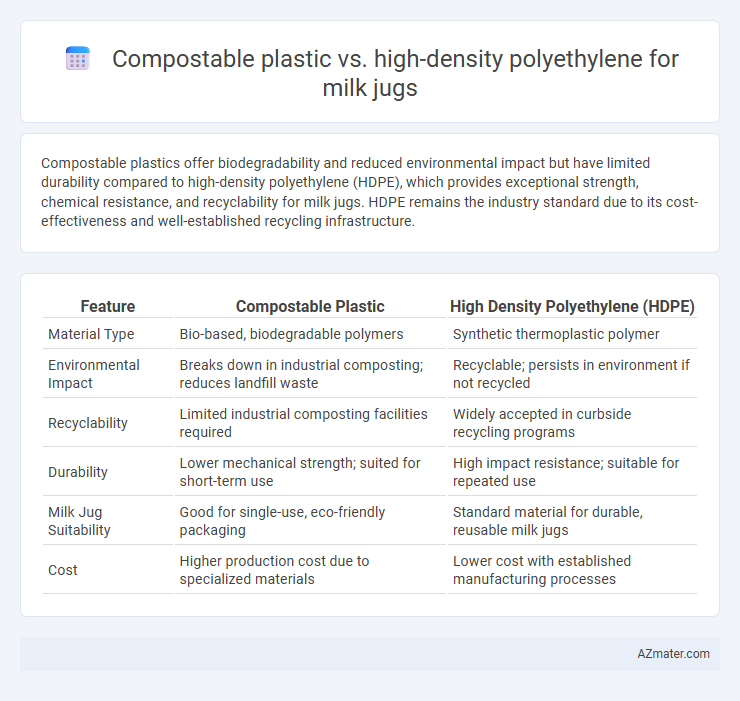Compostable plastics offer biodegradability and reduced environmental impact but have limited durability compared to high-density polyethylene (HDPE), which provides exceptional strength, chemical resistance, and recyclability for milk jugs. HDPE remains the industry standard due to its cost-effectiveness and well-established recycling infrastructure.
Table of Comparison
| Feature | Compostable Plastic | High Density Polyethylene (HDPE) |
|---|---|---|
| Material Type | Bio-based, biodegradable polymers | Synthetic thermoplastic polymer |
| Environmental Impact | Breaks down in industrial composting; reduces landfill waste | Recyclable; persists in environment if not recycled |
| Recyclability | Limited industrial composting facilities required | Widely accepted in curbside recycling programs |
| Durability | Lower mechanical strength; suited for short-term use | High impact resistance; suitable for repeated use |
| Milk Jug Suitability | Good for single-use, eco-friendly packaging | Standard material for durable, reusable milk jugs |
| Cost | Higher production cost due to specialized materials | Lower cost with established manufacturing processes |
Introduction to Milk Jug Packaging Materials
Milk jug packaging materials primarily include compostable plastics and high-density polyethylene (HDPE), each offering distinct environmental and functional benefits. Compostable plastics are designed to break down under specific composting conditions, reducing landfill waste and promoting sustainability. HDPE, a widely used thermoplastic polymer, provides excellent durability, chemical resistance, and recyclability, making it a standard choice for milk containers in retail markets.
What are Compostable Plastics?
Compostable plastics are biodegradable materials designed to break down into natural elements within a compost environment, typically made from renewable biomass sources such as corn starch or sugarcane. Unlike high density polyethylene (HDPE), which is a petroleum-based plastic known for its durability and recyclability, compostable plastics decompose through microbial activity, reducing environmental impact and landfill waste. Milk jugs made from compostable plastics offer an eco-friendly alternative that supports sustainable packaging by facilitating waste management through organic recycling processes.
High Density Polyethylene (HDPE) Explained
High Density Polyethylene (HDPE) is a widely used plastic for milk jugs due to its durability, chemical resistance, and recyclability, making it a preferred choice for food-grade containers. HDPE's molecular structure provides strength while maintaining flexibility, which helps prevent cracking and leakage during handling and transport. Unlike compostable plastics, HDPE offers a well-established recycling infrastructure that supports environmental sustainability through repeated processing and reuse.
Environmental Impact: Compostable Plastics vs HDPE
Compostable plastics for milk jugs break down more quickly in industrial composting facilities, reducing landfill waste and minimizing long-term environmental pollution. High-density polyethylene (HDPE) milk jugs are recyclable and widely accepted in curbside programs, but they persist in the environment for centuries if not properly recycled. The environmental impact of compostable plastics depends heavily on access to composting infrastructure, whereas HDPE's impact is mitigated by effective recycling systems and lower greenhouse gas emissions during production.
Durability and Shelf Life Comparison
High-density polyethylene (HDPE) milk jugs exhibit superior durability, resisting cracks and impacts throughout distribution and handling, which ensures extended shelf life and product safety. Compostable plastics, while environmentally beneficial, generally have lower mechanical strength and are more susceptible to moisture and temperature variations, leading to a reduced shelf life for milk products. Choosing HDPE provides enhanced barrier properties that maintain milk freshness longer compared to most compostable plastic alternatives.
Cost Analysis of Both Materials
Compostable plastics for milk jugs typically incur higher raw material and production costs due to specialized biopolymers and limited manufacturing scale compared to high-density polyethylene (HDPE), which benefits from established mass production and lower petroleum-based feedstock prices. HDPE offers superior cost-efficiency with consistent pricing volatility influenced by crude oil markets, whereas compostable plastics face price premiums driven by supply chain constraints and environmental compliance expenses. Lifecycle cost assessments highlight that while HDPE has lower upfront expenses, compostable plastics may reduce end-of-life environmental costs, potentially balancing total ownership costs depending on regional waste management policies.
Recycling and Composting Infrastructure Availability
High-density polyethylene (HDPE) milk jugs benefit from widespread recycling infrastructure, enabling efficient collection and processing into new plastic products with established market demand. Compostable plastics for milk jugs require specialized industrial composting facilities that are limited in availability, leading to challenges in consistent composting and potential contamination of recycling streams. The disparity in infrastructure availability makes HDPE a more viable option for sustainable waste management in the current recycling landscape.
Consumer Preferences and Market Trends
Consumer preferences for milk jugs increasingly favor sustainable options, driving interest in compostable plastics that offer environmental benefits over traditional high density polyethylene (HDPE). Market trends highlight a growth in demand for compostable packaging due to rising eco-consciousness and regulatory support, while HDPE remains dominant for its durability, recyclability, and cost-effectiveness. Notable shifts include major dairy brands piloting compostable jugs to balance consumer desire for sustainability with the proven performance of HDPE containers.
Regulatory Standards and Compliance
Compostable plastics used for milk jugs must comply with ASTM D6400 and EN 13432 standards, ensuring biodegradability and safe environmental decomposition, while High Density Polyethylene (HDPE) adheres to FDA 21 CFR 177.1520 regulations for food-contact safety and FDA-approved recycling protocols. Compostable milk jugs face stringent certification requirements for industrial composting facilities, contrasting with HDPE's well-established regulatory framework supporting widespread recycling and reuse. Regulatory compliance for HDPE emphasizes durability and contamination resistance, while compostable plastics prioritize eco-toxicity and breakdown performance under specific composting conditions.
Future of Sustainable Milk Jug Packaging
Compostable plastics offer a promising alternative to high-density polyethylene (HDPE) for milk jug packaging by reducing environmental impact through biodegradability and lowering carbon footprints. HDPE remains popular for its durability, recyclability, and cost-effectiveness, but advancements in compostable materials and improved biopolymer technologies drive innovation toward fully sustainable packaging. Future milk jug packaging will likely involve hybrid solutions that combine compostable plastics with enhanced recycling systems to meet consumer demand for eco-friendly, functional, and scalable options.

Infographic: Compostable plastic vs High density polyethylene for Milk jug
 azmater.com
azmater.com